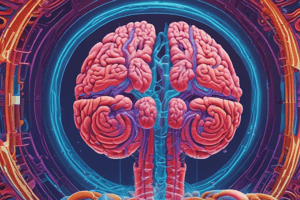Podcast
Questions and Answers
What role does the magnetic field play in MRI scans of the brain?
What role does the magnetic field play in MRI scans of the brain?
- It aligns the spins of proton atoms in hydrogen. (correct)
- It generates electrical impulses in the brain.
- It decreases the temperature of brain tissue.
- It enhances the absorption of water molecules.
Why is hydrogen significant in MRI imaging of the brain?
Why is hydrogen significant in MRI imaging of the brain?
- It creates a protective barrier around brain cells.
- It helps in generating high-frequency sound waves.
- The brain is primarily composed of water, which contains hydrogen. (correct)
- It is the most abundant element in the universe.
How is the final image produced in an MRI scan?
How is the final image produced in an MRI scan?
- By combining multiple chemical reactions.
- Through a compilation of many different snapshots. (correct)
- Through the alignment of oxygen atoms in the brain.
- By using real-time video monitoring of brain activity.
What types of images can be produced using MRI technology?
What types of images can be produced using MRI technology?
What is NOT a function of the magnetic field in MRI scans?
What is NOT a function of the magnetic field in MRI scans?
Study Notes
Magnetic Resonance Imaging (MRI)
- MRI uses a strong magnetic field to align the spins of protons in hydrogen atoms.
- Hydrogen is abundant in the brain due to its composition of water.
- The alignment of proton spins in the magnetic field creates a polarization.
- MRI generates static images by combining multiple snapshots of the brain.
- The technology allows for the creation of both 2D slices and 3D models of the brain structure.
Studying That Suits You
Use AI to generate personalized quizzes and flashcards to suit your learning preferences.
Description
Explore the fundamental principles of Magnetic Resonance Imaging (MRI) in this quiz. Understand how MRI utilizes strong magnetic fields to manipulate proton spins in hydrogen atoms, and how this technology produces both 2D and 3D images of the brain. Test your knowledge of MRI's application in brain imaging.




